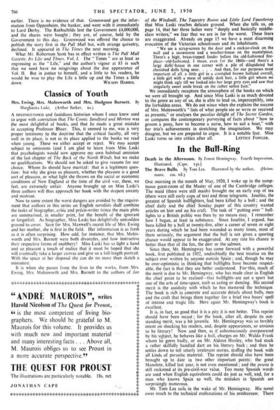In the Ill-Ring
ONE morning in the month of May, 1920, I woke up in the sump- tuous guest-room of the Master of one of the Cambridge colleges. The maid (there were still maids) brought me an early cup of tea (there were still early cups of tea) and three telegrams. Joselito, the greatest of Spanish bullfighters, had been killed by a bull ; and the chief daily and the chief Sunday paper of this country wanted articles on him and on his craft. The task of " putting over " bull- fights to a British public was then by no means easy. I remember how I began, at least in substance. Since Joselito, I argued, has been killed by a bull at twenty-five, after a career of seven or eight years during which he had been wounded as many times, most of them seriously, the argument that the bull is not given a sporting chance would appear to be exaggerated. At any rate his chance is better than that of the fox, the deer or the salmon.
Since then, Mr. Hemingway has come forward with a powerful book, first published in 1932, undoubtedly the best treatise on the subject ever written by anyone outside Spain ; and, though he may be over-optimistic in thinking that bullfights have become respect- able, the fact is that they are better understood. For this, much of the merit is due to Mr. Hemingway, who has made clear in English the chief point to be realised—that bullfights•are not a sport but one of the arts of time-space, such as acting or dancing. His second merit is the assiduity with which he has mastered the technique. The book is rich in concrete and accurate details about bulls, men and the craft that brings them together for a brief two hours' spell of intense and tragic life. Here again Mr. Hemingway's book is excellent.
It is, in fact, so good that it is a pity it is not better. This reprint should have been recast ; for the book, after all, despite its out- standing merit, was a bit juvenile. Mr. Hemingway was so terribly intent on shocking his readers, and, despite appearances, so anxious to be literary! Now and then, as if subconsciously overpowered by his subject, he behaves like a bull, charges on Mr. Waldo Frank whom he gores badly, or on Mr. Aldous Huxley, who had stuck a rather skilfully handled dart on his literary back ; and then he settles down to tell utterly irrelevant stories, stuffing the book with all kinds of parasitic material. The reprint should also have been brought up to date in two other important points: the great Manolete, killed last year, is not even mentioned ; and the peseta is still reckoned at its pre-civil-war value. Too many Spanish words are used when English equivalents could do just as well, and, for a man who knows Spain so well, the mistakes in Spanish are surprisingly numerous.
Mr. Tom Lea sails in the wake of Mr. Hemingway. His novel owes much to the technical explanations of his predecessor. There
is much information (such as that conveyed by the bull-breeder Balbuena to the bull-ring-owner G6mez for the benefit of the reader) which might have been (I don't say it is) lifted from Death in the Afternoon. There is the same literal translation of Spanish phrases, such as " to arm a scandal;" meaning a somewhat vociferous success ; but the plot is obvious, the characters thin, the episodes hasty and the talk smart to the point of boredom.
The Brave Bulls is a somewhat " photographic " description of Mexican bullfights and bullfighters, written by a painter. Curiously enough, the painter, though able to decorate his own book most attractively, does not seem to influence the novelist. " His mind drifted slowly away from nameable things,, out into the dark, into the blackness which was the colour of the bulls, the colour of the old man's coffin." One closes the book and wonders what is wrong. Surely the black of a coffin and the black of a bull's coat are too different to be bracketed together like that. And one remembers the symphony of blacks Manet made sing as a dirge of colour on his



































 Previous page
Previous page